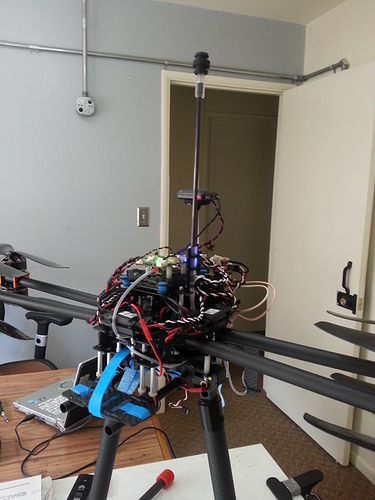Ok, I’ll start this off with the typical newbie introduction. After studying this for some time now, and using the recommended learning approach of learning to fly a small quad, I think I’m ready to take the next steps. My ultimate goal is to be able fly over 20 minutes while carrying various camera and other mapping related equipment. But for the first step, I want to focus on the main components while continuing to learn.
My first build is planned as follows:
Frame - Tarot 650 Sport
FC - Raspberry PI 2 Model B
Navio+
Motors - T-Motor MN5208
Props - APC 16 x 5.5
ESC’s - HW XRotor 40A
PDB/BEC - Pixnor PDB with Dual 5V and 12V Adjustable BEC’s (not sure about this, recommendations?)
LiPo - Dinogy 6S 11000 mAh
PM - Navio Power Module (question below)
AttoPilot 180A module
Manual TX - FrSky Taranis X9D Plus
RX - FrSky X8R
I’ve settled on using the PI / Navio+, the Tarot airframe, and the FrSky TX/RX for manual control. Using eCalc, along with my best other estimates toward AUW, the above config gives very good flight times.
Now the questions:
I want to explore converting this to an X8 as one of my next steps. Can anyone recommend vendors or sources of quality 16 and 17 inch props with a variety of pitches?
I am starting to realize that getting telemetry data to a ground control station / Mission Planner is not feasible without using a second TX/RX (separate from the X9D / X8R combo). I can’t fully get my mind wrapped around why two TX/RX systems are needed, but can someone explain this and recommend a second system? WiFi and cellular systems are interesting, but will probably not work for me due to range and coverage issues. Along these lines, can FPV TX/RX systems provide FPV goodies along with telemetry data to Mission Planner, or would FPV require a third TX/RX system?
I am also very interested in the GPS aspects of Navio+. I use precision GPS (L1/L2) equipment in my work daily, and already have everything I need to handle the base station aspects of an RTK system. Does anyone have experience with acquiring and using L1/L2 capable receivers and antennas that are suitable for quadcopter use?
I’ve seen here that there a wiring work-around to correctly get current and voltage info fed to Navio by eliminating the current and voltage wiring from the Navio PM, and feeding C and V data from the AttoPilot module like, LiPo -> BEC -> AttoPilot -> Navio, I think. However I am uncomfortable with the diagrams I’ve seen. Can someone clarify how the wiring should work?
Alright, fire away, it can’t hurt too bad.





